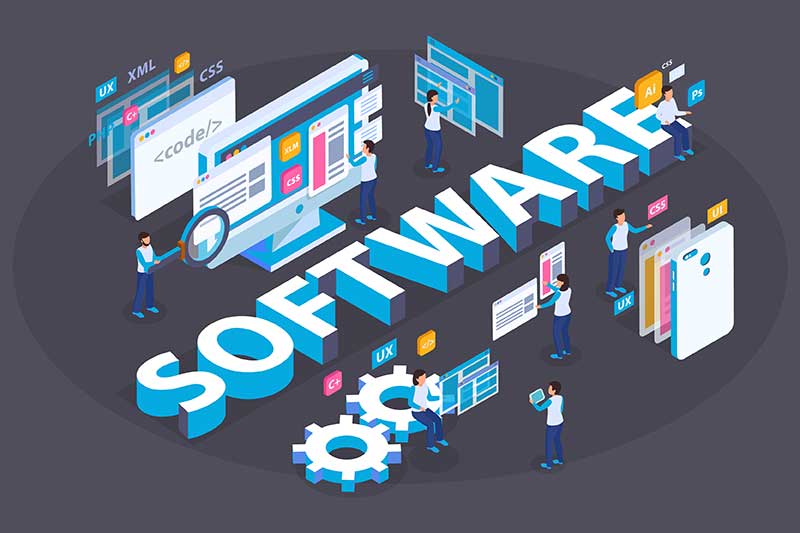The Ultimate Guide to Software Development in 2023
A re you ready to dive into the exciting world of software development and explore what lies ahead in 2023? Look no further, because we’ve got you covered with The Ultimate Guide to Software Development in 2023. Whether you’re a seasoned developer or just starting out, this comprehensive guide will provide all the insights, trends, and predictions you need to stay ahead of the game. Get ready for an engaging journey through the latest technologies, methodologies, and best practices that will shape the future of software development. So grab your coffee, buckle up, and let’s embark on this thrilling adventure together!
Just as every individual is distinct, custom development crafts software that mirrors the uniqueness of its purpose.
– Mehul Nahar
Introduction to Software Development
Software development is the process of creating, testing, and maintaining software applications. It involves planning, designing, coding, and testing software to ensure that it meets specified requirements.
There are many different types of software development methodologies, such as Agile, Waterfall, Iterative, and DevOps. Each has its own advantages and disadvantages, so it’s important to choose the right one for your project.
The first step in any software development project is to gather requirements from stakeholders. This helps you understand what they want the software to do and how they expect it to behave. Once you have a good understanding of the requirements, you can start designing the solution.
After the design is complete, you can start coding the software. This is where you write the actual code that will make the software work according to your design. Once the code is written, it needs to be tested to make sure it works as expected. If there are any bugs or errors, they need to be fixed before the software can be released.
Once the software is released, you need to monitor it and provide support if necessary. This includes ensuring that new features are added and bugs are fixed in a timely manner.
The Benefits of Software Development
Assuming you are referring to the benefits of software development for businesses, there are many. They include:
-Increased efficiency and productivity: Software can automate tasks that would otherwise be done manually, freeing up employees’ time to focus on other tasks. In addition, well-designed software can help employees work more efficiently by providing them with the information they need when they need it.
-Improved customer service: By automating tasks such as order processing and customer service requests, businesses can provide their customers with faster and better service. In addition, businesses can use data collected by their software to identify areas where customer service can be improved.
-Increased sales: Automated marketing and sales tools can help businesses increase their sales by reaching more customers and making it easier for them to make purchases. In addition, businesses can use data collected by their software to identify new sales opportunities.
-Reduced costs: Software can help businesses save money by automating tasks and processes, reducing the need for manual labor. In addition, businesses can use data collected by their software to identify areas where costs can be reduced.
Trends in Software Development for 2023
In the next few years, we will see a continued trend of software development moving towards more agile methods. This means that developers will be focusing on creating software that is easier to change and adapt, rather than trying to create perfect code from the start. This shift is being driven by the need for businesses to be able to respond quickly to changes in their marketplaces.
We will also see a continued trend towards using more open source software. This is because open source software allows businesses to save money on development costs, and it also makes it easier for them to customize the software to fit their specific needs. In addition, open source software tends to be more secure than proprietary software, which is another important consideration for businesses.
We will see an increase in the use of artificial intelligence and machine learning in software development. These technologies can help developers create programs that are smarter and more efficient. As these technologies become more advanced, we will likely see even more amazing applications of them in the field of software development.
Challenges Faced in Software Development
There are many challenges that can arise during the software development process. Perhaps the most common challenge is simply getting started. It can be difficult to determine what needs to be done and how to go about doing it. Once you have a plan, however, things tend to become much easier.
Other challenges include making sure that all of the code integrates properly, keeping track of changes, and managing different versions of the software. Additionally, testing can be a major challenge, especially if there are a lot of potential users. It’s important to make sure that the software is as user-friendly as possible before releasing it.
Technologies and Tools Used in Software Development
In software development, technologies and tools are used to create, test and deploy software applications. The most common technology used in software development is a code editor. A code editor is used to write, edit and debug code. There are many different code editors available, but some of the most popular ones include Visual Studio Code, Atom and Sublime Text. Other common technologies and tools used in software development include version control systems, issue tracking systems and project management tools.
How to Develop Quality Applications?
In the world of software development, there are two major approaches that organizations take to manage their projects: agile methodology and devops. Both have their own unique benefits and drawbacks, so it’s important to understand the differences between them before deciding which is right for your organization.
Agile methodology is a project management approach that values flexibility and collaboration. Its key principle is to break projects down into small increments, or “sprints,” so that they can be completed more quickly and with greater flexibility. This approach is well-suited for organizations that need to be able to respond quickly to changes in customer demands or market conditions.
Devops is a set of tools and practices that helps developers automate the process of software delivery and infrastructure management. It includes continuous integration, delivery, and deployment (CI/CD) tools that enable developers to work in short cycles and ensure that code changes are automatically tested and deployed into production. This approach is well-suited for organizations that have a large number of software dependencies or require strict control over their IT infrastructure.
Testing Strategies for Quality Assurance
There are many strategies for quality assurance testing, but not all of them are created equal. Here are four popular testing strategies that can help you ensure the quality of your software:
1. Black-box testing: This type of testing is based on the functionality of the software and does not require knowledge of the internal code or structure. Black-box tests can be used to test for usability, functional correctness, and compliance with external standards.
2. White-box testing: Unlike black-box testing, white-box testing requires knowledge of the internal code and structure. This type of testing is often used to test for logic errors and code coverage.
3. Gray-box testing: Gray-box testing is a combination of black-box and white-box testing. With this approach, testers have some knowledge of the internal code and structure, but they focus primarily on functionality.
4. Exploratory testing: This type oftesting is more open-ended than other approaches. Testers are free to explore the software in any way they see fit, looking for both positive and negative results.
Cloud Computing for Software Development
Cloud computing has revolutionized the way software is developed and deployed. In the past, software development was a slow and expensive process that required significant upfront investment. Today, with cloud computing, software can be developed much faster and at a fraction of the cost.
There are many benefits of using cloud computing for software development. First, it allows developers to quickly and easily provision the resources they need to get started developing their application. Second, it enables developers to scale their application up or down as needed, without incurring any additional costs. Cloud computing provides developers with access to a wide range of powerful tools and services that can make their job easier and improve the quality of their product.
Security Considerations in the Era of Digital Transformation
Digital transformation is inevitable in the modern world. The ever-growing dependence on technology has made it necessary for businesses to keep up with the latest trends in order to remain competitive. One of the most significant changes that has taken place in recent years is the way security is viewed and implemented. In the past, security was primarily a matter of keeping physical assets safe from harm. However, in the era of digital transformation, security must also encompass protecting data and systems from cyber threats.
There are a number of considerations that must be taken into account when planning for security in the era of digital transformation. First and foremost, it is important to understand the types of threats that exist and how they can impact your business. Cybercriminals are constantly evolving their methods, so it is essential to stay up-to-date on the latest trends in cybersecurity. Additionally, you must have a plan in place for how to respond to a breach if one occurs. This includes having backups of all critical data and systems as well as implementing security measures to prevent future attacks.
As businesses continue to digitize, it is imperative that security keeps pace. By taking into account the unique challenges posed by digital transformation, you can ensure that your business is protected against whatever comes your way.
Conclusion
As we can see, software development in 2023 is set to be a fascinating and ever-evolving field. Many of the trends we’ve discussed will become more prominent as time goes on, providing developers with new tools and opportunities to design innovative solutions for businesses. With AI and cloud computing playing an increasingly important role in how software is developed, now is the perfect time to start developing your skillset so that you can take advantage of these exciting changes.







